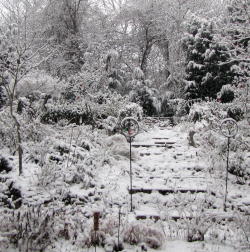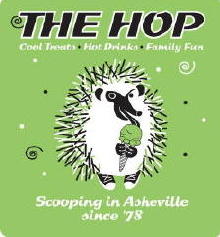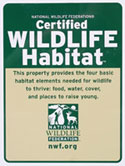.JPG)
This article in the New York Times,
http://travel.nytimes.com/2008/01/20/travel/20weekend.html?8dpc mentioned looking for winter interest in the garden by inspecting tree bark. Always on the lookout for winter interest here at Faire Garden, the camera and I went out to look for some of that intruguing bark. First shown is the trunk of one of the hemlocks,
tsuga canadensis, that form a privacy screen along the top of our hill. Planted eleven years ago, these have nicely provided a curtain of green. I am watching for the insect, wooly adelgid, that has damaged so many of the native hemlocks in the forests. Not wanting to jinx it,… no comment.
.JPG) Pyracantha, unknown cultivar, has an almost grid like look to its bark. There is a row of these tree/shrubs along the east side of the top of the hill, behind the shed, planted at the same time as the hemlocks. I guess it should be mentioned here that they were all planted by the semi adult children at that time. They also form a privacy screen with the bonus of white fuzzy flowers in spring and orangey red berries in fall. The birds love the thorny protection of the dense branching.
Pyracantha, unknown cultivar, has an almost grid like look to its bark. There is a row of these tree/shrubs along the east side of the top of the hill, behind the shed, planted at the same time as the hemlocks. I guess it should be mentioned here that they were all planted by the semi adult children at that time. They also form a privacy screen with the bonus of white fuzzy flowers in spring and orangey red berries in fall. The birds love the thorny protection of the dense branching.
.JPG) But this grid like look does not bode well for this pyracantha. Yellow bellied sap suckers, a woodpecker relative, hang around our area and this looks like the kind of damage they can do. It is really low to the ground, less than one foot, which seems unusual for them. In spite of whatever has happened to this tree, the birds are so attractive, a photo capturing them in action would surely make it to this site. But what can be done for this tree? Any ideas? Wrapping of some kind?
But this grid like look does not bode well for this pyracantha. Yellow bellied sap suckers, a woodpecker relative, hang around our area and this looks like the kind of damage they can do. It is really low to the ground, less than one foot, which seems unusual for them. In spite of whatever has happened to this tree, the birds are so attractive, a photo capturing them in action would surely make it to this site. But what can be done for this tree? Any ideas? Wrapping of some kind?
.JPG)
With a little more confidence about how to proceed, wax from a lit candle was dripped onto the fresh wound left from the removal of a large branch on the Yoshino flowering cherry,
prunus x yedoensis, out front. It has been four years since the cut was made, it was a big limb growing too low out into the street. Happily the wax kept the insects and water out but allowed the tree to form the proper scab.

Another embattled tree, this time a Loblolly pine,
pinus taeda, part of the woods that forms the property border near the street. In 2000, when most of the pine stands were lost to the southern pine beetle, we were watching this oozing area on the trunk of the largest of these trees. Somehow it is still living and the sap has dried. We still keep an eye on all the trees, however.

The same tree’s better side, mz. photographer, if you don’t mind. Why are you showing my imperfections?

Striations on the silver maple, the only other large tree on the property besides the pines.

What started out as an oak seedling mixed among the pines has now grown, although tall and skinny, to be higher than the pines themselves, at least thirty feet. If the day ever comes that the pines must come down, this is the hope for the future over there.

Really barkless, not interesting bark, this stump planter offers lots of nooks and crannies that create shadow art.

Probably what most people think about when the term interesting bark is mentioned, the row of riverbirches along the wooden fence near the house has entered its peeling stage.

For bringing the outside in, the bathrooms were wallpapered in this birch bark pattern. Interestingly, the images are photographs of real bark, and colored in soft greens and browns. The wallpaper in one of the bathrooms was removed this last year and the walls were painted a lovely robin’s egg blue. It was such a messy arduous task that the wallpaper seemed not needing replacement just yet in the guest bath.

From the same collection, this wallpaper border was applied to suggest a real birch log railing on the wall in the master bedroom. The lighter upper and dark paint below the limb make for a woodsy night’s sleep.
Dreaming of bark,
This entry was posted in
Musings. Bookmark the
permalink.
Pyracantha, unknown cultivar, has an almost grid like look to its bark. There is a row of these tree/shrubs along the east side of the top of the hill, behind the shed, planted at the same time as the hemlocks. I guess it should be mentioned here that they were all planted by the semi adult children at that time. They also form a privacy screen with the bonus of white fuzzy flowers in spring and orangey red berries in fall. The birds love the thorny protection of the dense branching.
But this grid like look does not bode well for this pyracantha. Yellow bellied sap suckers, a woodpecker relative, hang around our area and this looks like the kind of damage they can do. It is really low to the ground, less than one foot, which seems unusual for them. In spite of whatever has happened to this tree, the birds are so attractive, a photo capturing them in action would surely make it to this site. But what can be done for this tree? Any ideas? Wrapping of some kind?









Love the birch wallpaper, what a lovely idea!
Those are some lovely photographs of bark.
salix tree…thanks. Wallpaper is a hassle, but the limb border was easy to install.
I’m a fan of bark also, Frances, but this was an eyeopener, because I had no idea that pyracantha could get that big. (Mine is two feet tall and somewhat iffy in this climate, but enduring.)
I’ve had no problems with logging in to Blotanical, but send Stuart an email at stuart AT blotanical.com, and he should be able to sort things out for you.
jodi…thanks. I did finally get an email sent to Stuart, hopefully it will not get returned like the others. The internet has not been very cooperative for me today. Our pyracanthas are at least fifteen feet tall, but there may be dwarf varieties. Have you ever seen that type of damage though? We had a pine tree with that formation of holes, even saw the sapsucker pecking at it, and the tree died shortly after.
There really is beauty in anything. I never realized so many trees blessed the faire garden. Much Love.
chickenpoet…the groups of trees have grown well, even those planted by you!
Frances do you have rabbits that might be gnawing on the bark of the pyracanthus? They kind of look like teeth marks to me but I could be wrong. I’ve seen a poultice of sphagnum peat moss applied to tree wounds that may help it scab over and protect it. Good bark photos, I hope my little river birches grow to display some good bark like yours!
Dave…thanks. Rabbits have been seen in the area of the pyracantha, would they chew in a grid like that? Some kind of covering should probably be applied, or maybe chicken wire if it is rabbits. The river birches were planted as five gallon size seven years ago. They have had that peeling bark for at least four years now. I just love it.
We’ve had a sapsucker making wells on one holly tree for each of the last 2 winters and it hasn’t seemed to hurt the tree any. I’m kind of surprised because several of the branches appeared to be girdled, but so far, so good. I Googled after I first noticed the holes and opinion seems to be divided as to whether the wells are very harmful.
entangled…thanks. That gives me hope that the tree will survive.
I enjoyed your bark pictures. We must be on the same wavelength as I took pictures of bark just today! Not posted yet and none of the same as yours interestingly enough! Sweet!
I also love bark, & that Pyracantha bark is amazing! I don’t grow it, so I’ve never seen its bark. We had a couple of clumps of Birch at the house where I grew up. I loved the peeling bark, but my mom thought it looked “messy.” Not surprisingly, she has not planted any Birches at their current house. I don’t think my very well-drained soil would make for a happy Birch, so I’ll just admire from afar. I agree with Dave, get some chickenwire around that chewed up trunk. As long as there is some bark connecting the base to the top, it should survive.
layanee…thanks. Bark seems like a good topic for winter, I’ll be sure and look out for yours.
MMD…I will put some kind of barrier to stop whatever is gnawing at my pyracantha and hope it will make it to bloom and berry again. Thanks.
Loved the tour of the bark on your property. A bark I really like is the bark of a Sycamore tree. I know people think they are weed trees but I want one. I think they are gorgeous. Warblers are drawn to them.
My pyracantha has a long way to go to get as thick as yours. Whew it is a brute, a handsome brute.
lisa…thanks. Would you say the damage is sapsucker on the pyracantha? Or rabbit?